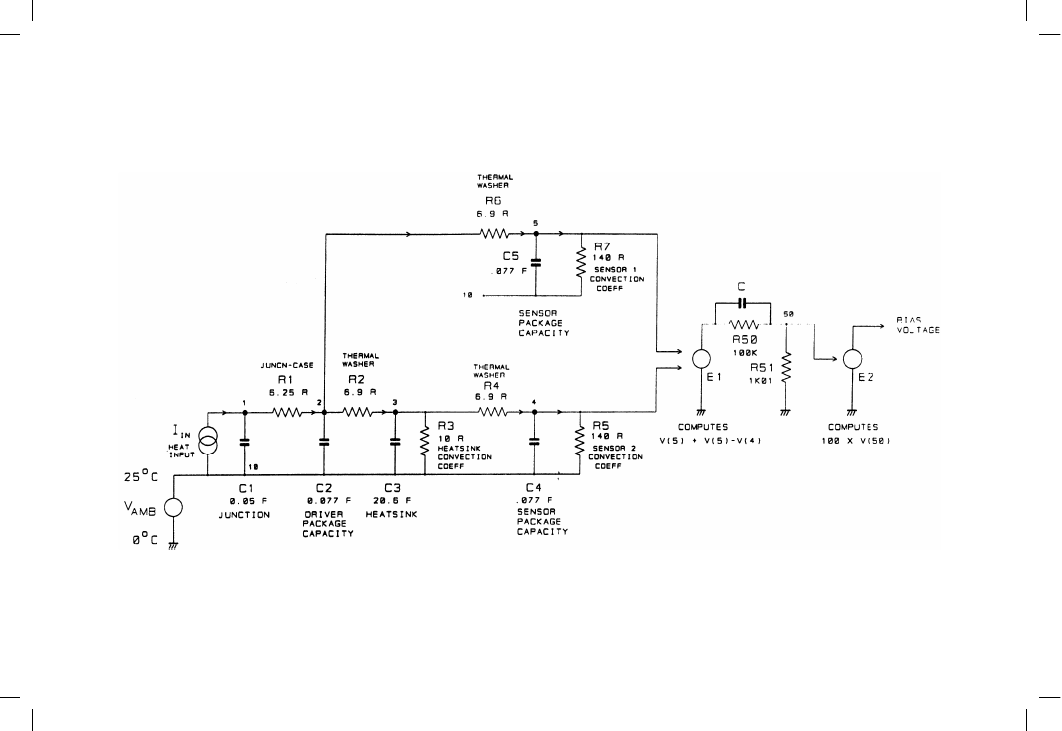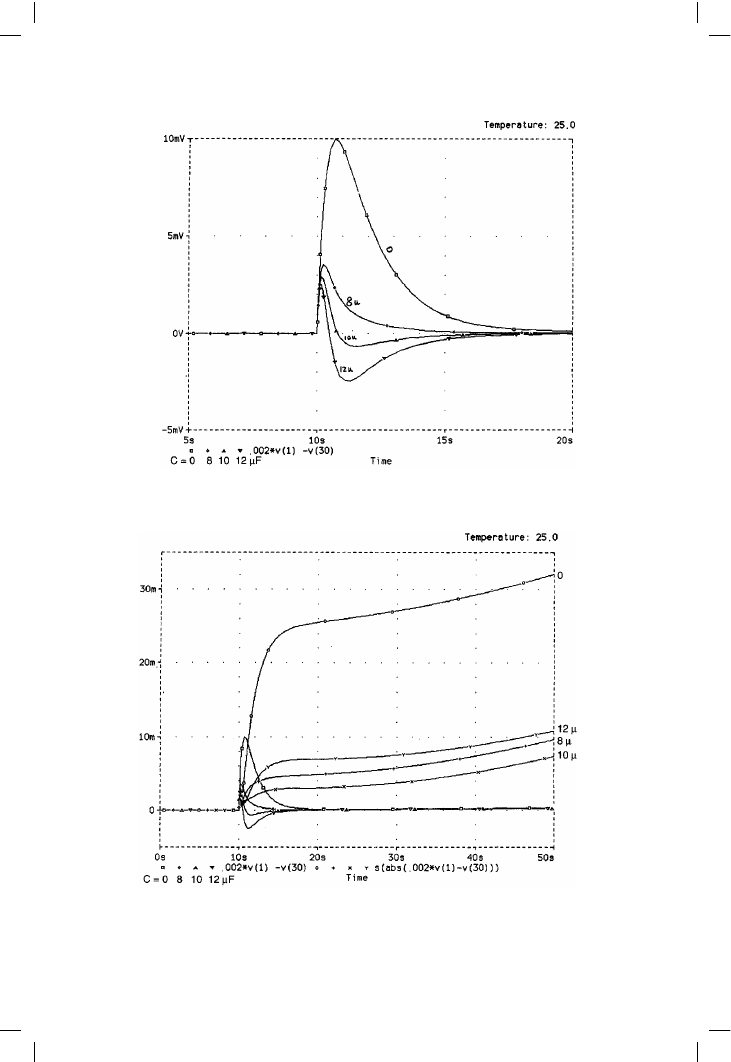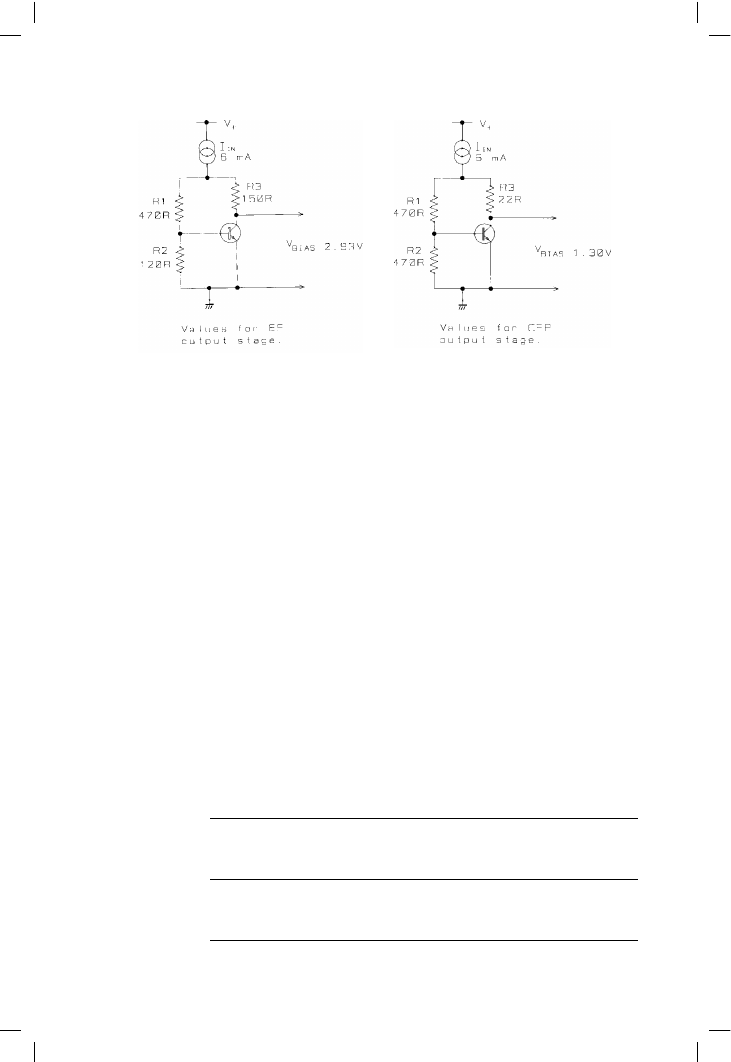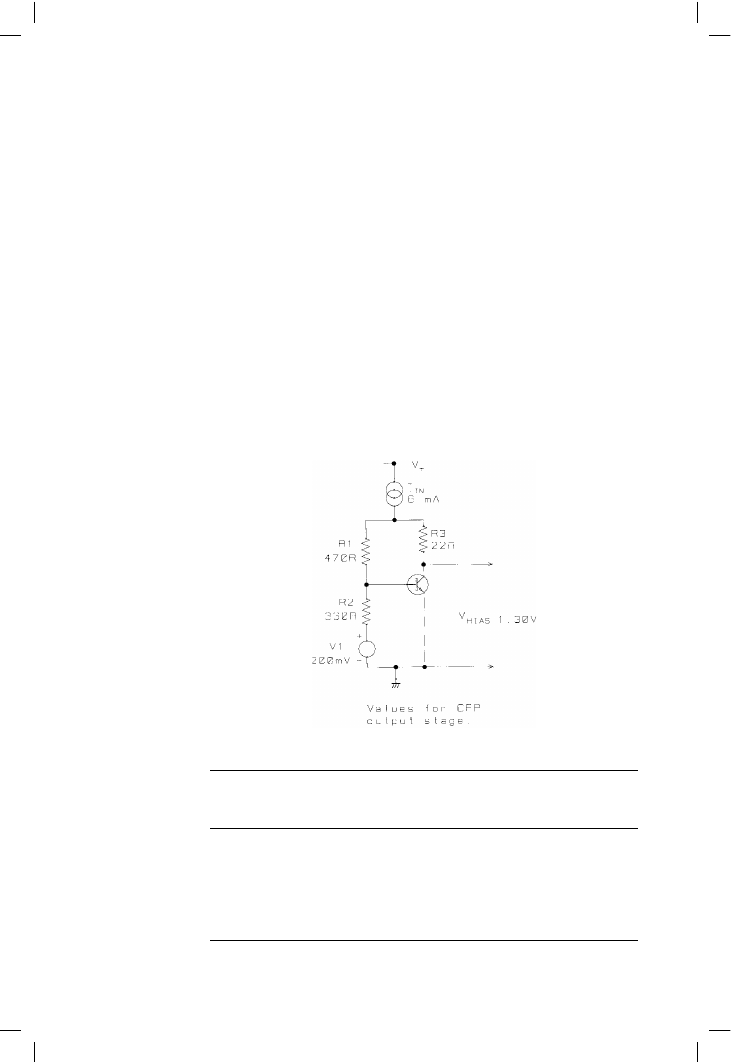ВУЗ: Казахская Национальная Академия Искусств им. Т. Жургенова
Категория: Учебное пособие
Дисциплина: Не указана
Добавлен: 03.02.2019
Просмотров: 17368
Скачиваний: 18

Figure 12.24
The conceptual circuit
of a junction-estimator
with dynamics. C gives
higher gain for fast
thermal transients and
greatly reduces the
effects of delay

Audio Power Amplifier Design Handbook
Figure 12.25
The initial transient errors for different values of C. Too high a value causes undershoot
Figure 12.26
The IAE for different values of C. 10 µF is clearly best for minimum integrated error (IAE = 7.3 mV-sec) but
even a rough value is a great improvement
356

Thermal compensation and thermal dynamics
With C set to 10 µF, the transient error falls within a +/–1 mV window
after only 0.6 seconds, which is more than twenty times faster than the
first improved CFP version (sensor put on driver) and gives a nicely
reduced IAE of 7.3 mV-sec at 50 seconds. The real-life circuitry to do this
has not been designed in detail, but presents no obvious difficulties. The
result should be the most accurately bias-compensated Class-B amplifier
ever conceived.
Conclusion
Some of the results of these simulations and tests were rather unex-
pected. I thought that the CFP would show relatively smaller bias errors
than the EF, but it is the EF that stays within its much wider tolerance
bands, with either heatsink or TO3-top mounted sensors. The thermal-
gain effect in the EF stage seems to be the root cause of this, and this in
turn is a consequence of the near-constant driver dissipation in the EF
configuration.
However, the cumulative bias errors of the EF stage can only be reduced to
a certain extent, as the system is never free from the influence of the main
heatsink with its substantial thermal inertia. In contrast the CFP stage gives
much more freedom for sensor placement and gives scope for more
sophisticated approaches that reduce the errors considerably.
Hopefully it is clear that it is no longer necessary to accept Vbe-multiplier
on the heatsink as the only option for the crucial task of Vbias
compensation. The alternatives presented promise greatly superior com-
pensation accuracy.
Variable-tempco bias generators
The standard Vbe-multiplier bias generator has a temperature coefficient
that is fixed by the multiplication factor used, and so ultimately by the value
of Vbias required. At many points in this chapter it has been assumed that
it is possible to make a bias generator with an arbitrary temperature
coefficient. This section shows how to do it.
Figure 12.27 shows two versions of the usual Vbe-multiplier bias generator.
Here the lower rails are shown as grounded to simplify the results. The first
version in Figure 12.27a is designed for an EF (Emitter-Follower) output
stage, where the voltage Vbias to be generated is (4
× Vbe) + Vq, which
totals +2.93 V. Recall that Vq is the small quiescent voltage across the
emitter-resistors Re; it is this quantity we are aiming to keep constant, rather
than the quiescent current, as is usually assumed. The optimal Vq for an EF
stage is in the region of 50 mV.
357

Audio Power Amplifier Design Handbook
The second bias generator in Figure 12.27b is intended for a CFP
(Complementary-Feedback-Pair) output stage, for which the required Vbias
is less at (2
× Vbe) + Vq, or approx 1.30 V in total. Note that the optimal Vq
is also much smaller for the CFP type of output stage, being about 5 mV.
It is assumed that Vbias is trimmed by varying R2, which will in practice be
a preset with a series end-stop resistor to limit the maximum Vbias setting.
It is important that this is the case, because a preset normally fails by the
wiper becoming disconnected, and if it is in the R2 position the bias will
default to minimum. In the R1 position an open-circuit preset will give
maximum bias, which may blow fuses or damage the output stage. The
adjustment range provided should be no greater than that required to take
up production tolerances; it is, however, hard to predict just how big that
will be, so the range is normally made wide for pre-production
manufacture, and then tightened in the light of experience.
The EF version of the bias generator has a higher Vbias, so there is a larger
Vbe-multiplication factor to generate it. This is reflected in the higher
temperature coefficient (hereafter shortened to ‘tempco’). See Table 12.4.
358
(a)
(b)
Figure 12.27
The classical Vbe-multiplier bias generator. Two versions are shown: for biasing EF (a) and (b) CFP output
stages. The EF requires more than twice the bias voltage for optimal crossover performance
Table 12.4
Vbias
volts
R1
!
R2
!
R3
!
Tempco
mV/°C
EF
2.93
120R
470R
22R
–9.3
CFP
1.30
470R
470R
150R
–3.6

Thermal compensation and thermal dynamics
Creating a higher tempco
A higher (i.e. more negative) tempco than normal may be useful to
compensate for the inability to sense the actual output junction tem-
peratures. Often the thermal losses to the temperature sensor are the major
source of steady-state Vbias error, and to reduce this a tempco is required
that is larger than the standard value given by: ‘Vbe-multiplication factor
times –2 mV/°C’. Many approaches are possible, but the problem is
complicated because in the CFP case the bias generator has to work within
two rails only 1.3 V apart. Additional circuitry outside this voltage band can
be accommodated by bootstrapping, as in the Trimodal amplifier biasing
system in Chapter 9, but this does add to the component count.
A simple new idea is shown in Figure 12.28. The aim is to increase the
multiplication factor (and hence the negative tempco) required to give the
same Vbias. The diagram shows a voltage source V1 inserted in the R2 arm.
To keep Vbias the same, R2 is reduced. Since the multiplication factor
(R1 + R2)/R2 is increased, the tempco is similarly increased. In Table 12.5,
359
Figure 12.28
Principle of a Vbe
multiplier with
increased tempco.
Adding voltage source
V1 means the voltage-
multiplication factor
must be increased to
get the same Vbias.
The tempco is therefore
also increased, here to
–4.4 mV/°C
Table 12.5
V1
mV
Vbias
V
R2
!
Tempco
mV/C
0
1.287
470
–3.6
100
1.304
390
–4.0
200
1.287
330
–4.4
300
1.286
260
–5.0
400
1.285
190
–6.9